 When it comes to maintaining a healthy smile, preserving your natural teeth is always a priority. While root canals are often highly effective at saving teeth by removing infection and sealing the root, there are cases where more specialized intervention is needed. That’s where an apicoectomy comes in—a procedure that could be the key to saving your tooth when a standard root canal isn’t enough.
When it comes to maintaining a healthy smile, preserving your natural teeth is always a priority. While root canals are often highly effective at saving teeth by removing infection and sealing the root, there are cases where more specialized intervention is needed. That’s where an apicoectomy comes in—a procedure that could be the key to saving your tooth when a standard root canal isn’t enough.
Performed by experienced specialists like Dr. Jon Jenson at Cascade Endodontics in Orem, UT, an apicoectomy involves endodontic microsurgery to remove infection and protect your overall oral health.
What Is an Apicoectomy?
An apicoectomy, also known as root end surgery, is an advanced dental procedure focused on treating the tip of a tooth’s root, otherwise known as the apex. This endodontic microsurgery is typically recommended when:
- An infection develops or persists after a root canal, despite prior treatment.
- A small fracture or canal within the root is unresponsive to traditional root canal techniques.
- Previous dental restorations prevent re-treatment via another standard root canal.
The procedure is designed to access the infected root tip, remove the source of the problem, and protect the integrity of the surrounding bone and gums. An apicoectomy helps ensure the tooth remains functional and pain-free while addressing issues that could lead to tooth loss.
What’s Involved with an Apicoectomy?
The process for an apicoectomy is straightforward yet highly precise. Dr. Jon Jenson and his team at Cascade Endodontics ensure that patient comfort and safety are central to the entire experience.
Step 1: Consultation and Planning
Before performing the procedure, Dr. Jenson will review your oral health history and take detailed X-rays or scans of the affected area. This allows for a custom-tailored plan that addresses the unique structure of your tooth and root.
Step 2: Local Anesthesia
To minimize discomfort, local anesthesia is administered to numb the area where the surgery will take place. Our patients often describe this step as similar to what you’d experience during a standard dental filling.
Step 3: Microsurgery
Using advanced surgical techniques, Dr. Jenson carefully accesses the root tip through a small incision in the gum tissue. The infected tissues surrounding the apex are removed, along with the damaged portion of the root tip itself.
Step 4: Filling and Resealing
Once the infection has been addressed, a biocompatible material is used to seal the root end. This prevents future infections from developing in the area. The gum tissue is then repositioned and sutured for proper healing.
Step 5: Recovery
Most patients recover quickly from an apicoectomy surgery, with mild swelling and soreness that subsides within a few days. Follow-up appointments will ensure proper healing and address any concerns.
Why Choose an Apicoectomy?
While root canals resolve most cases of tooth infection, an apicoectomy is a valuable option for cases where the infection persists or complicating factors are present. Here are some benefits of this procedure:
- Tooth Preservation: Avoid the need for extraction and maintain your natural tooth.
- Targeted Treatment: Effectively resolves infections localized at the root tip.
- Minimally Disruptive: Compared to extractions, an apicoectomy has a more straightforward recovery process and less impact on surrounding teeth.
Your Smile Deserves the Best Care
At Cascade Endodontics in Orem, UT, Dr. Jon Jenson and his skilled team are committed to providing exceptional care and innovative solutions for even the most complex dental issues. If you’re experiencing persistent tooth pain after a root canal or have been told you may need an apicoectomy, don’t hesitate to book a consultation.
Save your tooth while protecting your smile for years to come—contact Cascade Endodontics today!
